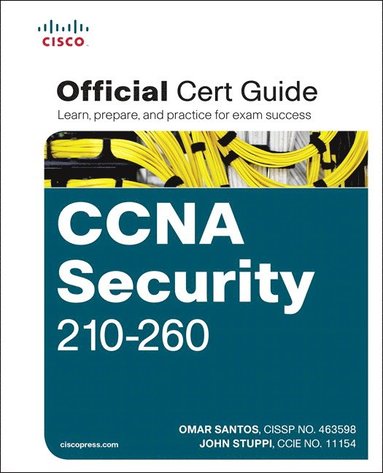
- Format
- Mixed media product
- Språk
- Engelska
- Antal sidor
- 608
- Utgivningsdatum
- 2015-09-03
- Upplaga
- 1
- Förlag
- Cisco Press
- Medarbetare
- Stuppi, John
- Dimensioner
- 236 x 190 x 38 mm
- Vikt
- Antal komponenter
- 2
- Komponenter
- Hardback (1), CD-ROM (1)
- ISBN
- 9781587205668
- 1189 g
CCNA Security 210-260 Official Cert Guide
Slutsåld
Kundrecensioner
Fler böcker av Omar Santos
-
Cisco ASA
Jazib Frahim, Omar Santos, Andrew Ossipov
Övrig information
Omar Santos is the technical leader for the Cisco Product Security Incident Response Team (PSIRT). He mentors and leads engineers and incident managers during the investigation and resolution of security vulnerabilities in all Cisco products. Omar has been working with information technology and cybersecurity since the mid-1990s. Omar has designed, implemented, and supported numerous secure networks for Fortune 100 and 500 companies and for the U.S. government. Prior to his current role, he was a technical leader within the World Wide Security Practice and the Cisco Technical Assistance Center (TAC), where he taught, led, and mentored many engineers within both organizations. Omar is an active member of the security community, where he leads several industrywide initiatives and standards bodies. His active role helps businesses, academic institutions, state and local law enforcement agencies, and other participants that are dedicated to increasing the security of the critical infrastructure. Omar is the author of several books and numerous white papers, articles, and security configuration guidelines and best practices. Omar has also delivered numerous technical presentations at many conferences and to Cisco customers and partners, in addition to many C-level executive presentations to many organizations. John Stuppi, CCIE No. 11154 (Security), is a technical leader in the Cisco Security Solutions (CSS) organization at Cisco, where he consults Cisco customers on protecting their network against existing and emerging cybersecurity threats. In this role, John is responsible for providing effective techniques using Cisco product capabilities to provide identification and mitigation solutions for Cisco customers who are concerned with current or expected security threats to their network environments. Current projects include helping customers leverage DNS and NetFlow data to identify and subsequently mitigate network-based threats. John has presented multiple times on various network security topics at Cisco Live, Black Hat, and other customer-facing cybersecurity conferences. In addition, John contributes to the Cisco Security Portal through the publication of white papers, security blog posts, and cyber risk report articles. Before joining Cisco, John worked as a network engineer for JPMorgan and then as a network security engineer at Time, Inc., with both positions based in New York City. John is also a CISSP (#25525) and holds an Information Systems Security (INFOSEC) professional certification. In addition, John has a BSEE from Lehigh University and an MBA from Rutgers University. John lives in Ocean Township, New Jersey (a.k.a. the "Jersey Shore") with his wife, two kids, and dog.
Innehållsförteckning
Introduction xxvi
Part I Fundamentals of Network Security
Chapter 1 Networking Security Concepts 3
Do I Know This Already? Quiz 3
Foundation Topics 6
Understanding Network and Information Security Basics 6
Network Security Objectives 6
Confidentiality, Integrity, and Availability 6
Cost-Benefit Analysis of Security 7
Classifying Assets 8
Classifying Vulnerabilities 10
Classifying Countermeasures 10
What Do We Do with the Risk? 11
Recognizing Current Network Threats 12
Potential Attackers 12
Attack Methods 13
Attack Vectors 14
Man-in-the-Middle Attacks 14
Other Miscellaneous Attack Methods 15
Applying Fundamental Security Principles to Network Design 16
Guidelines 16
Network Topologies 17
Network Security for a Virtual Environment 20
How It All Fits Together 22
Exam Preparation Tasks 23
Review All the Key Topics 23
Complete the Tables and Lists from Memory 23
Define Key Terms 23
Chapter 2 Common Security Threats 25
Do I Know This Already? Quiz 25
Foundation Topics 27
Network Security Threat Landscape 27
Distributed Denial-of-Service Attacks 27
Social Engineering Methods 28
Social Engineering Tactics 29
Defenses Against Social Engineering 29
Malware Identification Tools 30
Methods Available for Malware Identification 30
Data Loss and Exfiltration Methods 31
Summary 32
Exam Preparation Tasks 33
Review All the Key Topics 33
Complete the Tables and Lists from Memory 33
Define Key Terms 33
Part II Secure Access
Chapter 3 Implementing AAA in Cisco IOS 35
Do I Know This Already? Quiz 35
Foundation Topics 38
Cisco Secure ACS, RADIUS, and TACACS 38
Why Use Cisco ACS? 38
On What Platform Does ACS Run? 38
What Is ISE? 39
Protocols Used Between the ACS and the Router 39
Protocol Choices Between the ACS Server and the Client (the Router) 40
Configuring Routers to Interoperate with an ACS Server 41
Configuring the ACS Server to Interoperate with a Router 51
Verifying and Troubleshooting Router-to-ACS Server Interactions 60
Exam Preparation Tasks 67
Review All the Key Topics 67
Complete the Tables and Lists from Memory 67
Define Key Terms 67
Command Reference to Check Your Memory 67
Chapter 4 Bring Your Own Device (BYOD) 71
Do I Know This Already? Quiz 71
Foundation Topics 73
Bring Your Own Device Fundamentals 73
BYOD Architecture Framework 74
BYOD Solution Components 74
Mobile Device Management 76
MDM Deployment Options 76
On-Premise MDM Deployment 77
Cloud-Based MDM Deployment 78
Exam Preparation Ta...
Du kanske gillar
-
Lean Startup
Eric Ries
Häftad -
Empire of AI
Karen Hao
Inbunden -
Careless People
Sarah Wynn-Williams
Inbunden
